
Ford Madox Brown was a British painter of moral and historical subjects, notable for his distinctively graphic and often Hogarthian version of the Pre-Raphaelite style. Arguably, his most notable painting was Work (1852–1865). Brown spent the latter years of his life painting the twelve works known as The Manchester Murals, depicting Mancunian history, for Manchester Town Hall.

The Ashmolean Museum of Art and Archaeology on Beaumont Street, Oxford, England, is Britain's first public museum. Its first building was erected in 1678–1683 to house the cabinet of curiosities that Elias Ashmole gave to the University of Oxford in 1677. It is also the world's second university museum, after the establishment of the Kunstmuseum Basel in 1661 by the University of Basel.

The Pre-Raphaelite Brotherhood was a group of English painters, poets, and art critics, founded in 1848 by William Holman Hunt, John Everett Millais, Dante Gabriel Rossetti, William Michael Rossetti, James Collinson, Frederic George Stephens and Thomas Woolner who formed a seven-member "Brotherhood" partly modelled on the Nazarene movement. The Brotherhood was only ever a loose association and their principles were shared by other artists of the time, including Ford Madox Brown, Arthur Hughes and Marie Spartali Stillman. Later followers of the principles of the Brotherhood included Edward Burne-Jones, William Morris and John William Waterhouse.

Birmingham Museum and Art Gallery (BM&AG) is a museum and art gallery in Birmingham, England. It has a collection of international importance covering fine art, ceramics, metalwork, jewellery, natural history, archaeology, ethnography, local history and industrial history.

The Lady Lever Art Gallery is a museum founded and built by the industrialist and philanthropist William Lever, 1st Viscount Leverhulme and opened in 1922. The Lady Lever Art Gallery is set in the garden village of Port Sunlight, on the Wirral and one of the National Museums Liverpool.

Albert Joseph Moore was an English painter, known for his depictions of languorous female figures set against the luxury and decadence of the classical world.
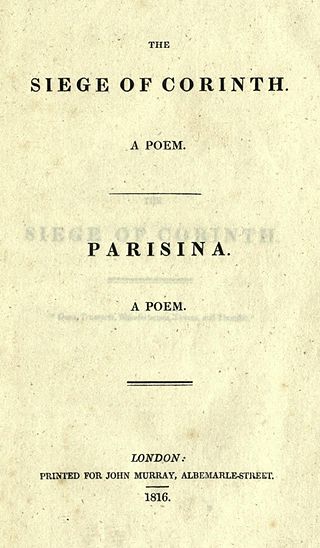
Parisina is a 586-line poem written by Lord Byron. It was probably written between 1812 and 1815, and published on 13 February 1816.
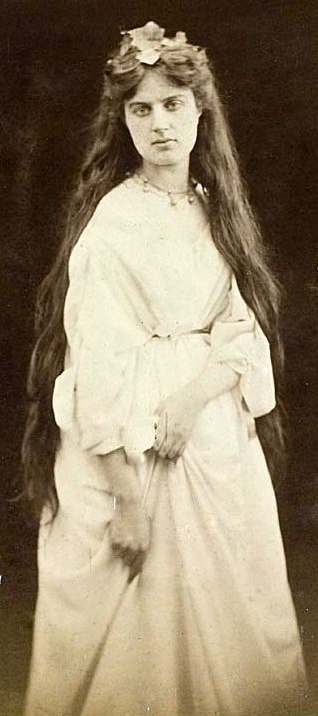
Marie Stillman was a British member of the second generation of the Pre-Raphaelite Brotherhood. Of the Pre-Raphaelites, she had one of the longest-running careers, spanning sixty years and producing over one hundred and fifty works. Though her work with the Brotherhood began as a favourite model, she soon trained and became a respected painter, earning praise from Dante Gabriel Rossetti and others.
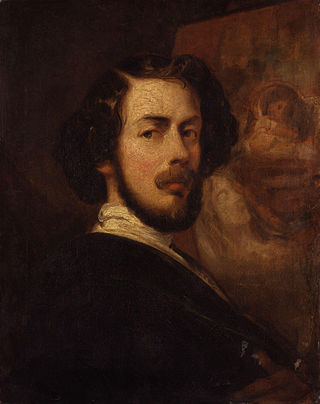
Thomas Jones Barker was an English historical, military, and portrait painter.

The Last of England is an 1855 oil-on-panel painting by Ford Madox Brown depicting two emigrants leaving England to start a new life in Australia with their baby. The painting has an oval format and is in the Birmingham Museum and Art Gallery.

Work (1852–1865) is a painting by Ford Madox Brown that is generally considered to be his most important achievement. It exists in two versions. The painting attempts to portray, both literally and analytically, the totality of the Victorian social system and the transition from a rural to an urban economy. Brown began the painting in 1852 and completed it in 1865, when he set up a special exhibition to show it along with several of his other works. He wrote a detailed catalogue explaining the significance of the picture.

The Manchester Murals are a series of twelve paintings by Ford Madox Brown in the Great Hall of Manchester Town Hall and are based on the history of Manchester. Following the success of Brown's painting Work he was commissioned to paint six murals for its Great Hall. Another six murals were to be completed by Frederic Shields who later withdrew, leaving Brown to complete all twelve works. The murals were begun in 1879, towards the end of Brown's career, but were not completed until 1893, the year he died. During this period he moved from London to Manchester with his family, first living in Crumpsall and then Victoria Park.

Beata Beatrix is a painting completed in several versions by Pre-Raphaelite artist Dante Gabriel Rossetti. The painting depicts Beatrice Portinari from Dante Alighieri's 1294 poem La Vita Nuova at the moment of her death. The first version is oil on canvas completed in 1870.
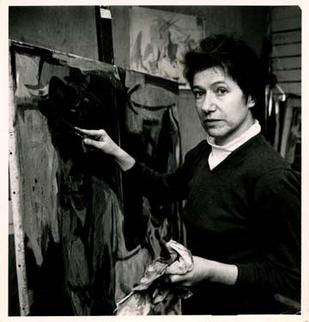
Janice Biala was a Polish-born American artist whose work, spanning seven decades, is well regarded both in France and the United States. Her work lies between figuration and abstraction. A modernist, she transformed her subjects into shape and color using "unexpected color relationships and a relaxed approach to interpreting realism."

Found is an unfinished oil painting by Dante Gabriel Rossetti, now in the Delaware Art Museum. The painting is Rossetti's only treatment in oil of a contemporary moral subject, urban prostitution, and although the work remained incomplete at Rossetti's death in 1882, he always considered it one of his most important works, returning to it many times from the mid-1850s until the year before his death.
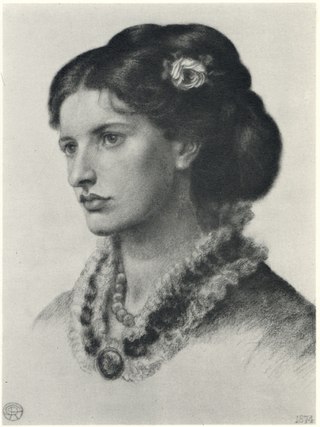
Lucy Madox Brown Rossetti was a British artist, author, and model associated with the Pre-Raphaelites. She was married to the writer and art critic William Michael Rossetti.

Catherine Madox Brown Hueffer, also known as Cathy, the first child of Ford Madox Brown and Emma Hill, was an artist and model associated with the Pre-Raphaelites and married to the writer Francis Hueffer.

Stages of Cruelty is an oil-on-canvas painting by Ford Madox Brown. He worked on the painting over an extended period, from 1856 to 1890. It is held by the Manchester Art Gallery.

View of Auvers-sur-Oise is the common English name for a Paul Cézanne painting known by various French names, usually Paysage d'Auvers-sur-Oise, or in the artist's catalogue raisonné, Groupe de maisons, paysage d'île de France. It is believed to have been painted in 1879–80, several years after Cézanne's residence in Auvers-sur-Oise, a small village northwest of Paris. The painting depicts a landscape of Northern France; the exact location has not been determined.


















